Greetings! This past week has been full of fun adventures, especially last Friday and Saturday when I got to participate in Happy Camper! Happy Camper is a two-day, one-night course on how to survive on the ice in Antarctica. Everyone who works outside McMurdo Station is required to take the course in the event that they get stranded somewhere on the continent. However, there are often openings available for people who aren't required to take the course, so I got to go! :)
There were twenty of us that day and we all piled into a Delta to head out to the ice shelf on the south side of Ross Island (south of Mt. Erebus, east of Scott Base). When we got there, the first thing we learned was how to start a fire with a Whisperlite International stove. Jim and I would use a Whisperlite stove whenever we went camping, so this was a skill I already knew and I was able to help others who were learning for the first time.
 |
| Poeple and luggage crammed into the Delta |
 |
| Marcie, I, and Ryan (L-R) learn how to use a stove. |
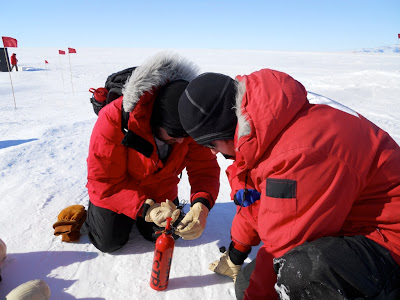 |
| Getting the stove attached to the fuel cannister can be a bit tricky. |
We then learned how to set up four-season tents and Scott tents. The four-season tents were very much like the tents most people use when they go camping; however, Scott tents (named for Robert Scott) are specifically designed for camping in the extreme cold. They are the big yellow tents in the photos below.
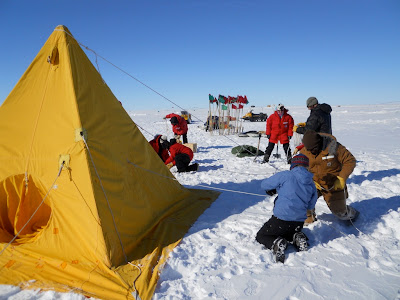 |
| Getting the Scott tent set up |
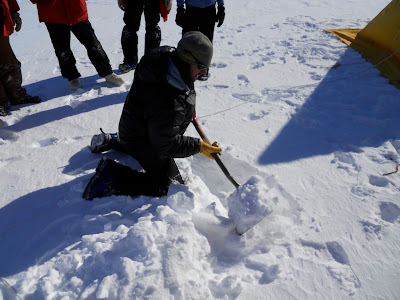 |
| To secure the Scott tent, we wrapped the tent cords around a bamboo stick and buried it under about a foot of snow. |
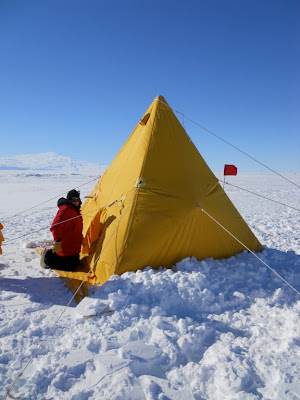 |
| The last step was to put lots of snow on the flaps around the edges (except at the opening) to keep the wind from getting under the tent. |
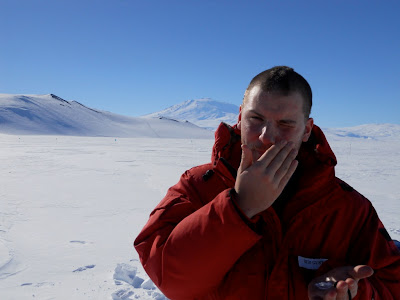 |
| My friend Reid reapplies sunscreen after working out in the sunlight. The UV radiation is extremely intense in Antarctica because it all gets reflected by the ice and snow. Even though I applied sunscreen on my face, I got seriously sunburned on the underside of my nose because of the UV reflection. Ouch! |
After getting the tents set up, we built a wall of snow bricks to block the winds should a storm come up overnight. On Ross Island, bad weather always comes directly from the south, so we built the brick wall on the southern side of the tents. To create the bricks, we used a handsaw to cut them out of the snow and a shovel to lift them off the ground.
 |
| Here I am cutting bricks with the handsaw. |
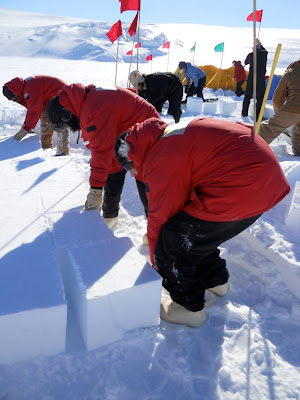 |
| More brick-cutting. |
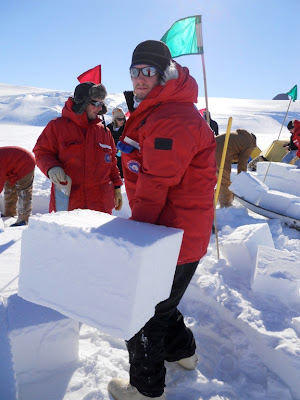 |
| My friend Ryan is shoveling the bricks from the snow quarry to the wall. |
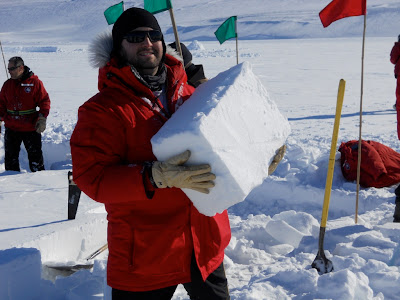 |
| After sawing for a while, I decided to try carrying some bricks. They probably weighed anywhere between twenty and thirty pounds. |
 |
| Reid had a smart idea to pile several bricks on a sled and drag them to the site of the wall. :) |
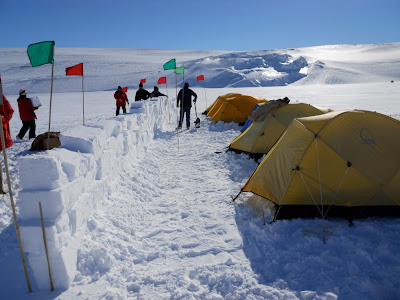 |
| The completed wall stands about four feet high to protect the tents from any potential bad weather. Fortunately, the bad weather never came. :-D |
 |
| The outhouse where we took care of business |
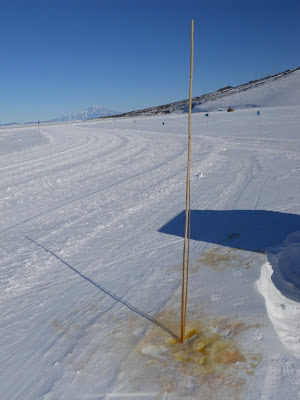 |
| The pee pole for the guys. Mmmm... yellow snow. :) |
 |
| A view of Mt. Discovery from the ice shelf. The green buildings in the mid-ground are Scott Base. |
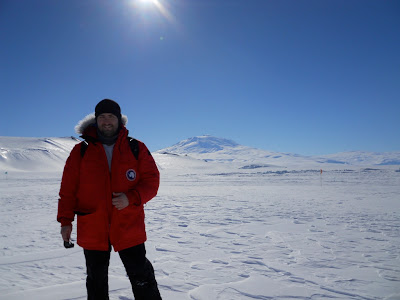 |
| Here I stand in front of Mt. Erebus. The volcano wasn't steaming on this day, although it often does. |
After setting up the tents and the tent wall, we ate dinner and our instructors left us students to spend the rest of the evening by ourselves. Of course, we had a radio by which we could contact our instructors in case of an actual emergency, but the idea was to simulate being stranded in the middle of nowhere in Antarctica. Several people planned to sleep that night in one of the tents, but some of us pursued other arrangements: the ice trench. If you're stranded with a broken tent or no tent, you can always dig a hole in the ground and sleep there. :) So, my friend Marcie and I decided to dig a double trench that we could both sleep in.
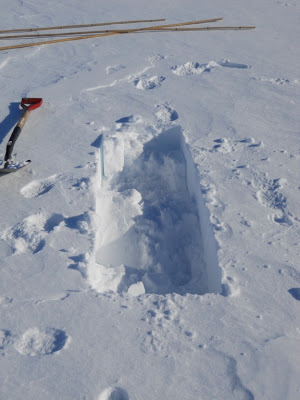 |
| Here's the hole that I dug to begin creating the trench. |
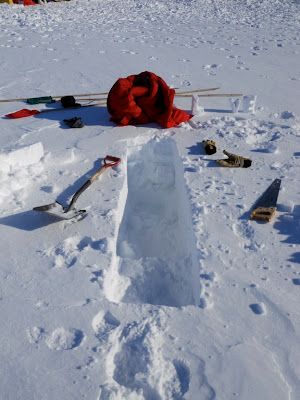 |
| The trench gets a little bit deeper. |
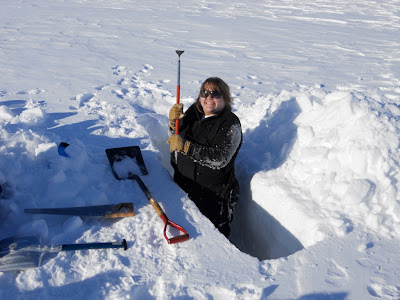 |
| After digging for a while myself, I let Marcie take over for a bit. |
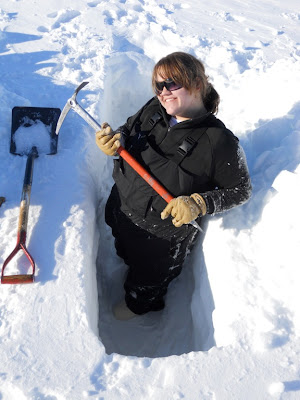 |
| Marcie had a real knack for hacking through the snow and ice. |
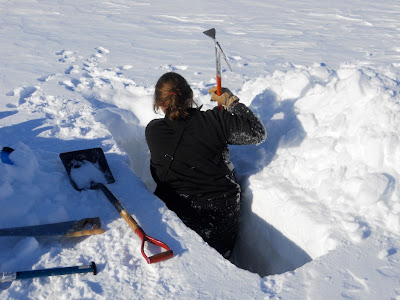 |
| Hack, hack, hack... |
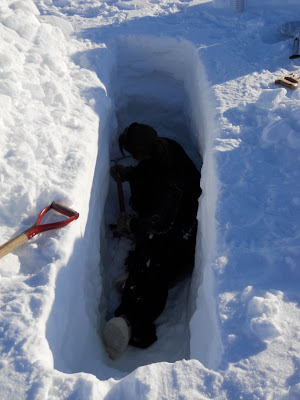 |
| The trench begins to look like something someone could sleep in. |
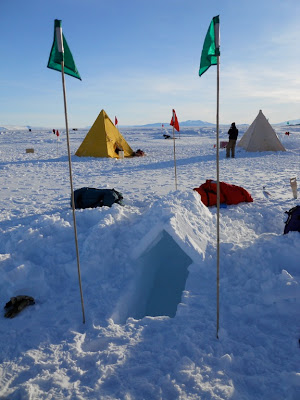 |
| Finally it's finished! We added snow bricks on top to create a roof and put flags at the front and back ends to prevent people from accidentally stepping into it. |
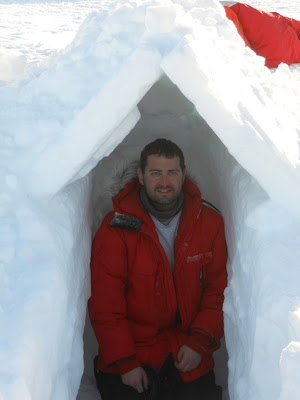 |
| A tight fit, but it works. |
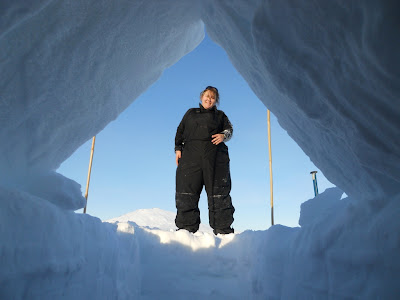 |
| From the inside looking out. |
 |
| It was really snug with two people inside but at least we were able to keep warm. |
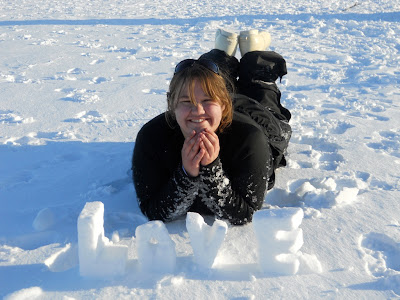 |
| Marcie made snow letters to form the word "LOVE" outside our trench. |
Despite building a cozy trench, I had trouble sleeping. I kept waking up throughout the fully sunlit night. At 4:15, I climbed out of the trench and walked around outside for a bit. The sun was low in the southern sky and there was absolutely no sound anywhere: no people (everyone else was still sleeping), no seals, no penguins, nothing. It was amazing and overwhelming to stand in such immense silence and stillness.
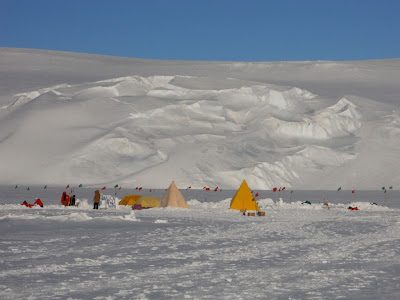 |
| The campsite at 4:15am. Behind is a view of the ice sheet on Ross Island, riddled with cracks. |
 |
| My water bottle froze overnight (as did my socks and shoes). |
After breakfast the next morning, we learned how to operate a ham radio and practiced a couple of survival scenarios. In the first one, we imagined that we had survived a helicopter crash and using only a survival kit, a radio, and a few flags, we enacted how we would respond. In the second scenario, we had to find someone who had gotten lost in total whiteout conditions. We simulated such conditions by wearing buckets on our heads.
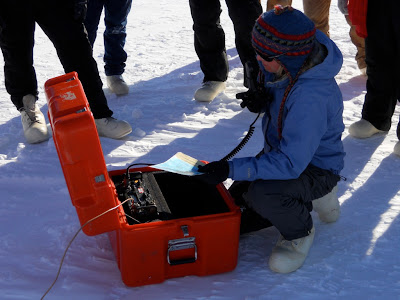 |
| My friend Britt uses a ham radio to get in touch with Operations at McMurdo Station. |
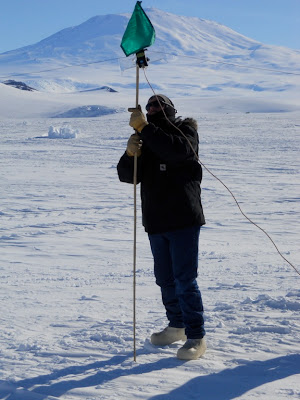 |
| The ham radio requires a very long antenna wire to be held up at three points, each about ten feet apart. |
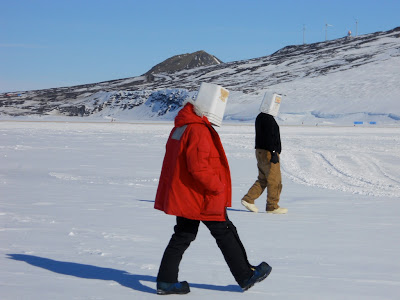 |
| One exercise that we did was to try to walk in a straight line with a bucket on our heads, something that was very difficult to do. If we were ever stranded in Antarctica during a white out, trying to get from point A to point B would be equally difficult. |
After getting back to station from Happy Camper, I slept like a rock the next night. It was a lot of fun but very exhausting. It's nice to know that I could survive were I to get stuck somewhere though.
Separate from Happy Camper, another exciting event that happened earlier that week: my first spotting of PENGUINS!! There were two of them and they were about fifteen feet away from me. They didn't come any closer, instead choosing to just waddle by.
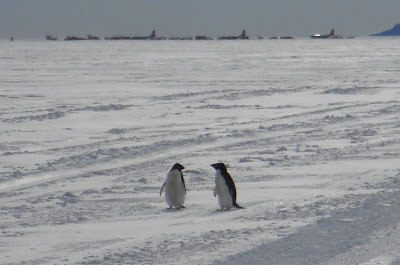 |
| Two Adélie penguins appeared on the ice shelf while driving back to McMurdo Station. You can see the planes on the sea ice runway in the background. |
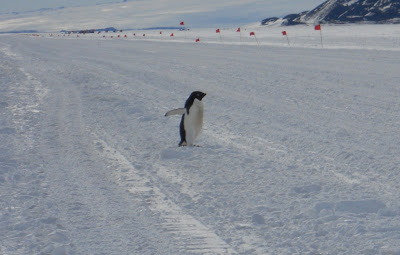 |
| Flap those wings! :) |
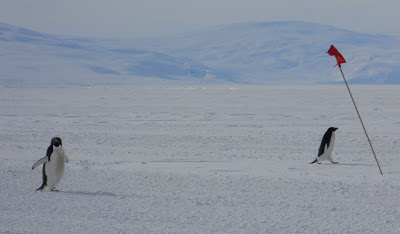 |
| Aren't they cute? :) |
 |
| Scootin' away... |
 |
| Bye-bye penguins! Come back soon! |
For those of you who are interested in learning more about life at McMurdo Station, I recommend the film "Encounters at the End of the World", directed by German film director Werner Herzog. Happy Camper is one of the things he films and you can see a little bit more of what happens during the course. :)
:-O Happy FEET!!!!!
ReplyDeleteI want penguins.........lucky bastard.
ReplyDeleteI will no longer tell people from out of state that it's starting to get cold here in Colorado! Great post Joseph. Fun to read as always.
ReplyDeleteAwesome written and visual report, Joseph! How cool! I love the pics and the adventure, and yay penguins!! So exciting to know that you are happy and well in Anartica!! : )
ReplyDeleteWe are so lucky to have you reporting this adventure.... just amazing.....thank you! When you were up early, and it was so quiet and even over whelming... you said you heard nothing... does the ice ever make cracking sounds?
ReplyDeleteLove your comments and the pictures and totally appreciate the time it takes to load the pics and then write about them....
Fantastic post Joseph. Glad you got the chance to participate in the Happy Camper program. Now THAT was a Wilderness Survival School!!!
ReplyDeleteI am very envious of your penguin encounter - penguins are one of my top two favorite animals (turtles being the other). Great photos!
Also, I have seen Werner Herzog's "Encounters at the End of the World", and agree that it is a great insight into the lives of people, like you, who choose to go down to McMurdo Station. I thought of that film when you told me you were going. Keep up the great posts! Janine